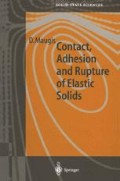Abstract
One can date the development of the linear elasticity from 1676, the year when Robert Hooke proposed his anagram ceiiinosssttuu which he explained two years later as ut tensio sic vis (force is proportional to extension). Since then, several centuries of experiments have been needed to distinguish the various fields of linear and nonlinear elasticity, plasticity, viscoelasticity, viscoplasticity, and almost two centuries of thinking to introduce concepts which appear familiar today. If we think that the usual concept of pressure in a fluid, defined as the force per unit area that an element exerts on a neighbouring element, appeared only with Jean Bernoulli and Euler around 1750, that Coulomb in 1773 was the first to consider the stresses acting on various planes passing by the same point and the first to introduce the concept of shear stress on a plane, we can understand that the foundations of elasticity do not appear self-evident for anyone who approaches elasticity for the first time.
Access this chapter
Tax calculation will be finalised at checkout
Purchases are for personal use only
Preview
Unable to display preview. Download preview PDF.
References
S. Timoshenko, J.N. Goodier: Théorie de l’élasticité (Béranger, Paris 1961)
N.I. Muskhelishvili: Some basic problems of the mathematical theory of elasticity (Noordhoff, Leyden 1975)
A.C. Stevenson: Proc. Roy. Soc. A 184, 129 (1945)
H.W. Westergaard: Trans. ASME 61, A49 (1936)
G.C. Sih: Int. J. Fracture 2, 628 (1966)
J. Eftis, H. Liebowitz: Int. J. Fracture 8, 383 (1972)
C.T. Sun, T.N. Farris: Int. J. Fracture 40, 73 (1989)
J.W. Harding, I.N. Sneddon: Proc. Cambridge Phil. Soc. 41, 16 (1945)
I.N. Sneddon: The use of integral transforms (Mc Graw-Hill, New-York 1972)
R.W. Little: Elasticity (Prentice-Hall, 1973)
C.E. Inglis: Trans. Inst. Nav. Arch. 55, 219 (1913)
D. Maugis: Eng. Fracture Mech. 43, 217 (1992)
K.J. Chang, H.C. Wu: J. Appl. Mech. 47, 57 (1980)
J. Dundurs: ASME J. Appl. Mech. 36, 650 (1969)
Author information
Authors and Affiliations
Rights and permissions
Copyright information
© 2000 Springer-Verlag Berlin Heidelberg
About this chapter
Cite this chapter
Maugis, D. (2000). Elements of Elasticity. In: Contact, Adhesion and Rupture of Elastic Solids. Springer Series in Solid-State Sciences, vol 130. Springer, Berlin, Heidelberg. https://doi.org/10.1007/978-3-662-04125-3_2
Download citation
DOI: https://doi.org/10.1007/978-3-662-04125-3_2
Publisher Name: Springer, Berlin, Heidelberg
Print ISBN: 978-3-642-08538-3
Online ISBN: 978-3-662-04125-3
eBook Packages: Springer Book Archive

